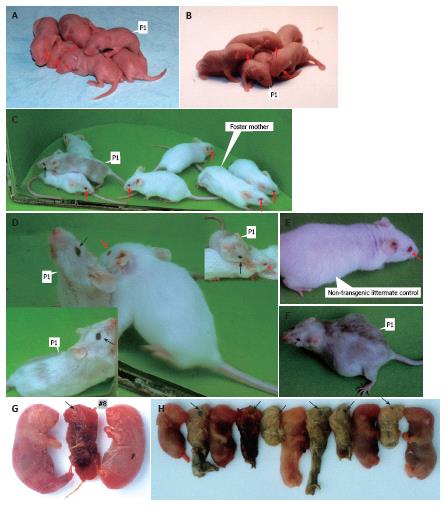Copyright
©2007 Baishideng Publishing Group Co.
World J Gastroenterol. Jan 14, 2007; 13(2): 244-249
Published online Jan 14, 2007. doi: 10.3748/wjg.v13.i2.244
Published online Jan 14, 2007. doi: 10.3748/wjg.v13.i2.244
Figure 2 Eye and coat colors of tyrosinase minigene transgenic Kunming albino mice.
One foster mother gave birth to six F0 pups (A-F); among the littermates, only one mouse (referred to as P1) had the pigmented eyes at birth. On July 15, another foster mother produced three F0 pups (G); of three siblings, only one mouse (referred to as #8) indicated the pigmented eyes at birth. P1 (♀) was crossed with normal Kunming albino mouse to give birth to 11 F1 offspring (H). All of the common albino strains of laboratory mice, such as FVB/N, BALB/c, and Kunming mouse (in China), have pink eyes and albino skin. (A and B) The 2-d-old littermates. At birth, one pigmented mouse (P1) with dark eyes could be easily and immediately identified as a transgenic mouse by simple visual inspection. (C) The 4-wk-old littermates and Kunming albino foster mother. Founder P1 exhibited black eyes and light grey fur when compared to the non-transgenic littermate controls and Kunming albino foster mother with pink eyes and albino skin. No differences in phenotypes between transgenic mouse and the controls and foster mother except for melanization in eyes and hairs. Actually, the Kunming albino mouse was also used as a recipient strain for TyBS transgene in this project. (D) Eye color of the 4-wk-old P1 mouse compared with one of the non-transgenic littermates. One of the non-transgenic littermates (right of the middle map) had pink eyes, while at this age the heterozygote P1 (left of the middle map, upper and lower) had nearly black eyes. (E and F) The 8-wk-old non-transgenic littermate control and the adult P1 mouse (8-wk old), respectively. The non-transgenic littermate control (E, left) had pink eyes and albino coat, while at this age the heterozygote P1 mouse (F, right) had nearly black eyes and dark grey coat. Over time, the coat of P1 mouse became more heavily pigmented, while the eye and fur phenotypes of non-transgenic littermate control remained pink and albino throughout the life, respectively. (G) Eye color of the 1.5-d old #8 compared with its littermates. At birth, #8 with dark eyes could be easily and immediately identified as transgenic mice by simple visual inspection. Unfortunately, #8 as well as non-transgenic littermates without dark eyes were killed by foster mother 1.5 d after birth. (H) Eye color of F1 offspring (11) developed from mating of P1 and normal Kunming albino mouse. Founder P1 (♀) was back-crossed to normal Kunming albino mouse to produce eleven F1 generation. Unluckily, all of F1 offspring (11), born on September 8, died immediately at birth. P1 also deceased one month after delivery as it did not recover from giving birth to pubs. Of the 11 animals that developed from the mating aforementioned, six mice exhibited pigmented eyes. → and → indicate the pigmented eyes and non-pigmented eyes (pink), respectively.
- Citation: Xiao D, Yue Y, Deng XY, Huang B, Guo ZM, Ma Y, Lin YL, Hong X, Tang H, Xu K, Chen XG. Rescue of the albino phenotype by introducing a functional tyrosinase minigene into Kunming albino mice. World J Gastroenterol 2007; 13(2): 244-249
- URL: https://www.wjgnet.com/1007-9327/full/v13/i2/244.htm
- DOI: https://dx.doi.org/10.3748/wjg.v13.i2.244









